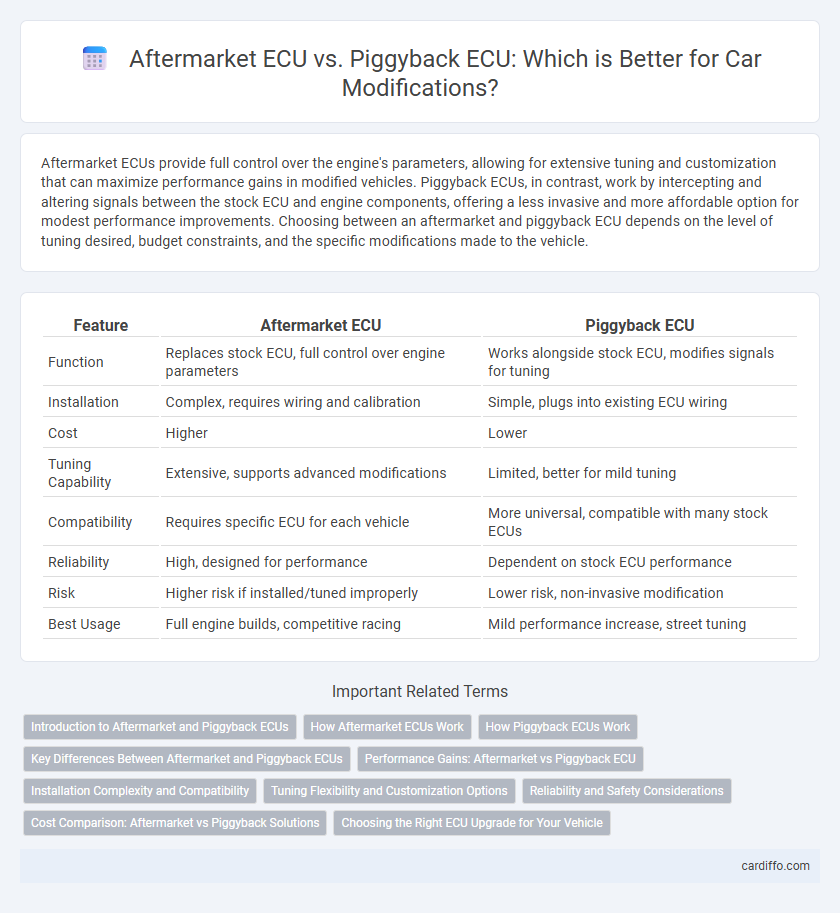Aftermarket ECUs provide full control over the engine's parameters, allowing for extensive tuning and customization that can maximize performance gains in modified vehicles. Piggyback ECUs, in contrast, work by intercepting and altering signals between the stock ECU and engine components, offering a less invasive and more affordable option for modest performance improvements. Choosing between an aftermarket and piggyback ECU depends on the level of tuning desired, budget constraints, and the specific modifications made to the vehicle.
Table of Comparison
| Feature | Aftermarket ECU | Piggyback ECU |
|---|---|---|
| Function | Replaces stock ECU, full control over engine parameters | Works alongside stock ECU, modifies signals for tuning |
| Installation | Complex, requires wiring and calibration | Simple, plugs into existing ECU wiring |
| Cost | Higher | Lower |
| Tuning Capability | Extensive, supports advanced modifications | Limited, better for mild tuning |
| Compatibility | Requires specific ECU for each vehicle | More universal, compatible with many stock ECUs |
| Reliability | High, designed for performance | Dependent on stock ECU performance |
| Risk | Higher risk if installed/tuned improperly | Lower risk, non-invasive modification |
| Best Usage | Full engine builds, competitive racing | Mild performance increase, street tuning |
Introduction to Aftermarket and Piggyback ECUs
Aftermarket ECUs offer complete control over engine parameters by replacing the factory ECU, enabling extensive tuning and customization for performance enhancement. Piggyback ECUs work alongside the stock ECU, intercepting and modifying sensor signals to adjust engine behavior without full ECU replacement. Both systems improve vehicle performance, but aftermarket ECUs provide deeper calibration capabilities, while piggyback solutions offer easier installation and retain factory ECU safety features.
How Aftermarket ECUs Work
Aftermarket ECUs replace the factory engine control unit entirely, offering full control over engine parameters such as fuel injection, ignition timing, and boost pressure, enabling precise tuning for performance and efficiency. These ECUs use advanced software and hardware interfaces to access sensor data, process inputs, and manage actuators in real-time, allowing for comprehensive customization at a system-wide level. Unlike piggyback ECUs that modify signals sent to and from the stock ECU, aftermarket ECUs directly command engine functions, providing greater flexibility for complex modifications and racing applications.
How Piggyback ECUs Work
Piggyback ECUs modify engine performance by intercepting and altering sensor signals between the factory ECU and engine components, allowing for adjustments without replacing the original control unit. They manipulate parameters such as fuel injection timing, boost pressure, and ignition timing to enhance power and efficiency while maintaining factory safety protocols. This approach provides a flexible and often reversible tuning solution compared to comprehensive aftermarket ECU replacements.
Key Differences Between Aftermarket and Piggyback ECUs
Aftermarket ECUs replace the factory ECU entirely, offering complete control over engine parameters such as fuel maps, ignition timing, and boost levels. Piggyback ECUs work alongside the stock ECU by intercepting and modifying sensor signals to enhance performance without fully overriding the factory system. The main difference lies in the level of customization and control, with aftermarket ECUs providing comprehensive tuning capabilities, while piggyback units offer a simpler, plug-and-play upgrade.
Performance Gains: Aftermarket vs Piggyback ECU
Aftermarket ECUs provide comprehensive control over engine parameters, allowing significant performance gains through advanced tuning and customization, often supporting increased horsepower and torque. Piggyback ECUs offer more limited adjustments by modifying sensor signals, resulting in moderate performance improvements without fully replacing the factory ECU. The choice between aftermarket and piggyback ECUs depends on the desired level of engine management precision and the extent of performance enhancement required.
Installation Complexity and Compatibility
Aftermarket ECUs require extensive installation complexity involving custom wiring, sensor calibration, and often ECU flashing, making them suitable for enthusiasts seeking full control over engine parameters. Piggyback ECUs offer easier installation with plug-and-play compatibility, intercepting sensor signals without replacing the factory ECU, ideal for moderate tuning while maintaining OEM functions. Compatibility of aftermarket ECUs demands precise matching with engine models and firmware, whereas piggyback units typically support a broader range of vehicles with minimal adjustments.
Tuning Flexibility and Customization Options
Aftermarket ECUs offer extensive tuning flexibility by allowing full control over engine parameters such as fuel maps, ignition timing, and boost levels, enabling deeper customization for performance optimization. Piggyback ECUs work by intercepting and modifying signals from the stock ECU, providing limited tuning options but easier installation and compatibility with factory features. Enthusiasts seeking advanced customization and comprehensive adjustments prefer aftermarket ECUs, while those valuing simplicity and partial tuning choose piggyback systems.
Reliability and Safety Considerations
Aftermarket ECUs offer extensive tuning capabilities but may pose higher risks to engine reliability and safety if not properly calibrated, as they replace the factory control system entirely. Piggyback ECUs enhance performance by modifying sensor signals while retaining the original ECU, generally maintaining better reliability and safety due to limited interference with the vehicle's built-in fail-safes. Choosing between the two requires weighing the benefits of comprehensive control against the potential complexity and risks introduced, prioritizing fuel mapping precision and system redundancy to protect engine integrity.
Cost Comparison: Aftermarket vs Piggyback Solutions
Aftermarket ECUs generally carry a higher upfront cost compared to piggyback ECUs due to their full engine management capabilities and advanced tuning options. Piggyback ECUs offer a more budget-friendly solution, typically costing less because they work alongside the factory ECU rather than replacing it entirely. Maintenance and potential upgrade expenses should also be factored in, with aftermarket ECUs sometimes requiring more frequent professional tuning to maximize performance.
Choosing the Right ECU Upgrade for Your Vehicle
Aftermarket ECUs offer comprehensive control over engine parameters, providing extensive customization options for performance tuning and fuel management. Piggyback ECUs complement the stock ECU by intercepting and adjusting sensor signals, allowing for targeted modifications without fully replacing the factory system. Choosing the right ECU upgrade depends on the desired level of control, budget, and compatibility with your vehicle's existing setup.
Aftermarket ECU vs Piggyback ECU Infographic

 cardiffo.com
cardiffo.com